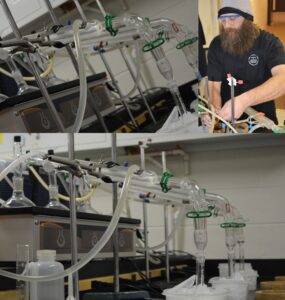
When it comes to distilled spirits alcohol content, Brewing and Distilling Analytical Services (BDAS) believes producers deserve the best analytical services with the goal of elevating the quality of their products. BDAS is proud of supporting growth and success of locally produced products. We have years of experience in proofing spirits. We excel in developing analytical methods, statistically interpreting data, and producing meaningful reports. Our goal at BDAS is to provide test services as efficiently as possible to maximize our customers’ profits, through our equipment, conducted by our team of analytical specialists. BDAS is TTB certified in wine, spirits, and beer.
The system for proofing spirits in the United States was established around 1848 and was created for liquors above 40 proof in strength. Proof is straight up two times alcohol by volume. Thus, a vodka that is 40 percent ABV is 80 proof and one that is 45 percent ABV is 90 proof. A proof spirit is 100 proof (50 percent ABV) or higher. In the U.S., a baseline was settled on in the mid-19th century, making a 50% alcohol by volume spirit exactly 100 proof.
All spirits go through at least two procedures – fermentation and distillation. Fermentation is where all alcohol is created, distillation is where the alcohol is separated and removed. Distilling is essentially the process whereby a liquid made of two or more parts is separated into smaller parts of desired purity by the addition of heat.
Beer and wine have a much lower alcohol content than liquor, ruling out the need for a proof designation. When you consider the origin of the term proof, it makes sense that alcohol would need to be higher in proof to even be scaled by the proof system. The average beer comes in at around 5 percent ABV and the average glass of wine is around 12 percent. Technically you could acknowledge that your beer is 10 proof because it contains 5 percent ABV, but it isn’t necessary, and you definitely won’t find it on a label.
Different kinds of spirits or hard liquor tend to have average or typical proof measurements:
• Rum | Typical modern rum beverages range between 70-100 proof (35-50% ABV), with the most common being 80 proof.
• Cachaça | It is typically between 70-100 proof, though it tends to be on the lower end of this range.
• Tequila | Typical tequila bottles will have between 80-100 proof on their label (40-50% ABV), with few exceptions to this range.
• Mezcal | Is a type spirit similar to tequila that is Mexican in origin with alcoholic content in the 80-100 proof range.
• Gin | It is typically made between 70-100 proof (35-50% ABV).
• Whiskey | There are many forms of whiskey, including scotch, rye, and bourbon, all of which have different manufacturing processes. However, each of these related subtypes is typically between 70-120 proof (35-60% ABV).
• Vodka | Each bottle of vodka also varies the most in proof, with different types being anywhere from 80-190 proof (40-95% ABV).
• Cognac | Almost all types of cognac are 80 proof (40% ABV), regardless of which distiller or distillery made them.
• Liqueur | Amaretto, Baileys, Kahlua, and other liqueurs are typically the lowest proof spirits. Most in this category are between 30-60 proof (15-30%), and the majority are on the lower end.
For more information about alcohol content of distilled spirits at Brewing and Distilling Analytical Services (BDAS), contact us in Lexington, Kentucky at (859) 278-2533 or in Denver, Colorado at (720) 450-7066.